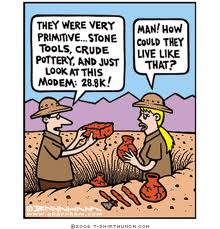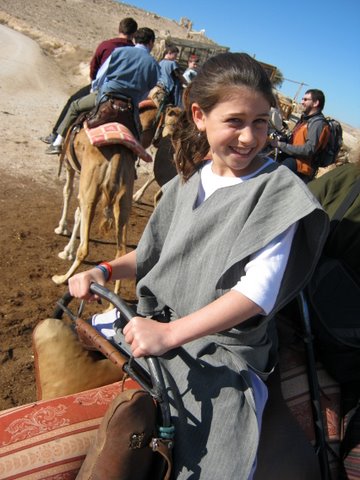Distance Learning: Closer than It Looks:
I teach online, through live video conferencing, from my home in Jerusalem to over 20 schools in the US, Canada and England. These schools contract with my company, JETS, for a number of educational courses on global Jewish issues, Israel education and culture, and Jewish Bible and history.
During my time as an online educator, I’ve used a variety of video conferencing platforms, such as Skype, Webex, Adobe ProConnect and Polycom video conferencing hardware. I have taught students in public schools, Catholic schools and Jewish Day Schools and complementary schools, live. Schools use projectors and microphones to ensure quality video and audio performance, the courses are completely interactive, and I have received very positive feedback.
But there is something that catches my eye each time I run a session: it’s the human reaction to these technology-supported events. My children often walk into my home studio and stare at my screen, not knowing if the people they see are in Memphis, Vancouver or London. At the other end, people (both teachers and adults) become very excited about the following:
• My eight-year old son walks in, holding his cat.You have a pet in Israel?
• My five-year old daughter comes to give me a hug in her pajamas. What time is it there, anyway?(Israel is 7 hours ahead of EST, and most of my classes are conducted at night in Israel).
• I share with students in Toronto how the students in Miami reacted to the very same question we are currently addressing: Why did people in ancient times choose to live in a cave?Toronto response: to get out of the cold. Miami response: to get out of the heat, a cave has built-in air conditioning!
These incidents are part of my everyday online teaching & learning life, and they help students feel connected.
Why choose online learning?
Being an online instructor, I am constantly answering questions from my peers in Israel. “Why would they want you to teach their students? Don’t they have teachers?” And I repeat what I’m sure many online instructors have stated before:
• Access an expert in the field.
• Share with your students a different point of view.
• Jewish and Catholic schools have a vested interest in learning about Israeli sites, history and culture from someone on the ground.
These are all valid points and I wave my flag for them every day. But underneath all that, I think there is a need, in today’s wired world, to connect to another person far away, living a different, yet somehow similar life. I love sharing in my students’ curiosity about my life, and I love learning about theirs.
 For example: Archaeology is a huge topic in Israel. No highway can be dug, no hospital built, until the Israel Antiquities Authority goes in first and ensures that no ancient civilization is waiting to be uncovered. I wanted to share this idea during a distance learning session with some students in Miami who were studying Lifestyles in Ancient Israel. I suggested they dig up their backyards (they all have big backyards, of course, relative to the apartment city blocks in Jerusalem). “What do you think you will find?” I asked. Blank stares met my eyes.
For example: Archaeology is a huge topic in Israel. No highway can be dug, no hospital built, until the Israel Antiquities Authority goes in first and ensures that no ancient civilization is waiting to be uncovered. I wanted to share this idea during a distance learning session with some students in Miami who were studying Lifestyles in Ancient Israel. I suggested they dig up their backyards (they all have big backyards, of course, relative to the apartment city blocks in Jerusalem). “What do you think you will find?” I asked. Blank stares met my eyes.
Oops, wrong question, I tell myself. I’m originally from Southern California. I can reshape this question. I ask “how many of you have swimming pools in your backyard?” Every hand goes up. “Imagine a crew would come in and dig underneath your swimming pools — what do you think they would find?”
“Create a time capsule,” I suggest, “of what people would find in Miami.”
Students work in groups, tossing out answers, arguing among themselves. Rocks, animal bones, bricks, they propose.
“Now create a time capsule of what we find in Jerusalem!” After a few sessions together, students understand that the list will grow substantially: pottery shards, jewelry, weapons, skeletons, ancient seals and religious artifacts. Students realize how historical Israel is as a culture, how many nations have conquered this region and lived here, and how much there is to gain from studying ancient and modern Israel. When I show them a video of my daughter digging up a jug on an ancient dusty road, the idea comes to life. Another connection has been made. “Did your daughter really find that jug?” they ask. I smile. “What do you think?”
Here’s the video – it’s the introduction to our program about children’s lifestyles in ancient Israel.
My partners and I put many hours of preparation into each of our lessons. Slides, questions, activities and videos are carefully planned and plotted. I get great feedback, don’t get me wrong. But when my online students joyfully greet my children, or watch the sky darken behind me as they set off to lunch, I realize that they are learning, reflecting, internalizing — educating themselves about things I never planned. I marvel that they create these connections independently and revel in the wonderful, wide world in which we live.

No comments:
Post a Comment